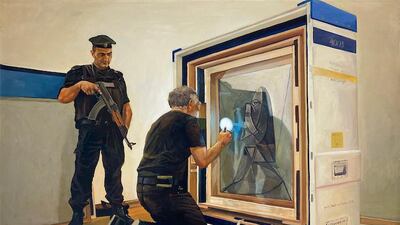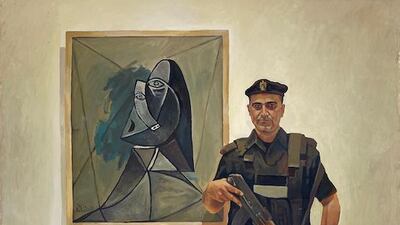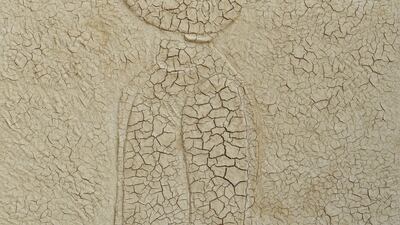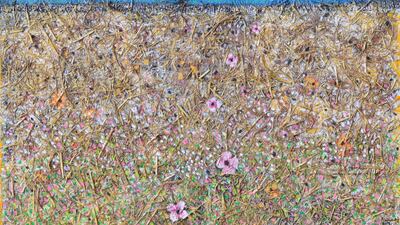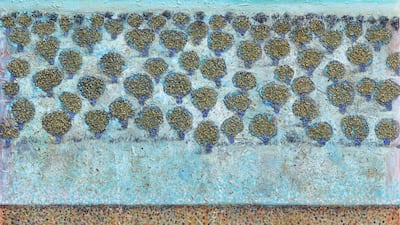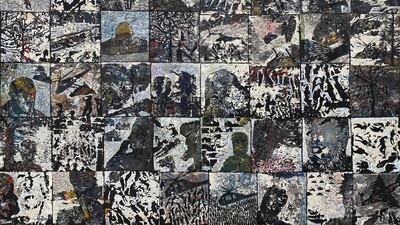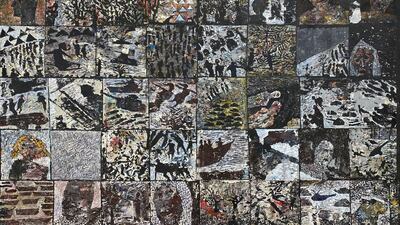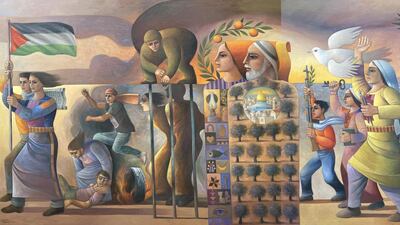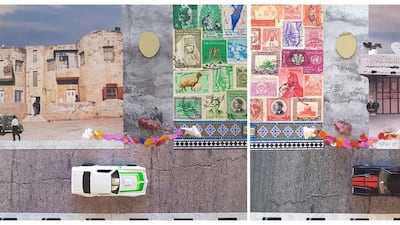It’s hard to talk about Palestine without talking about the occupation. The same goes for Palestinian art, in which resistance and identity continue to be central themes across decades of artistic production.
These narratives inevitably emerge in the Dubai exhibition Palestinian Art: Resilience and Inspiration at Zawyeh Gallery. The space was founded in Ramallah in 2013, and having participated at Art Dubai and Abu Dhabi Art on numerous occasions, the gallery opened in Alserkal Avenue, Dubai, this year. Its roster of artists, including those in the show, mostly live and work in Ramallah.
The exhibition opens with Sliman Mansour's Woman Picking Olives, a symbolic vision of the Palestinian connection to the land, as hinted by the tree and the traditional dress worn by the woman in the painting. It exemplifies the romanticism and nostalgia that Mansour's paintings are known for, though this mood begins to shift with the other works in the exhibition.
In comparison, Tayseer Barakat's Light in the Dark paintings are more abstract and haunting, reflecting not a dream-like version of Palestine, but its reality. His canvases contain many squares depicting scenes from the region's turbulent history, from the Nakba in 1948 and the Intifadas to the West Bank wall and Israeli invasions. Barakat produced the works by layering and gluing canvases on top of each other, ripping them off and repainting them to result in a moulting, textured surface that underscores the grimness of the subject.

The contrast between Palestine rendered as an abstract ideal versus an existing complex territory repeats throughout the show. It is in these shifting perspectives that the show is able to find some footing. Revolution Was the Beginning, another work by Mansour, is brimming with defiance and nationalist sentiment as it traces the history of Palestinian resistance, replete with symbols of peace and the right to return. Nabil Anani's Demonstration series, showing the cohesiveness of an occupied community, also leans towards a broader, more hopeful view of Palestinian resilience.
Meanwhile, in another part of the exhibition, Khaled Hourani's paintings from his project Picasso in Palestine bring us back down from these reveries. Hourani's project involved a collaboration between the International Academy of Art Palestine, where the artist serves as artistic director, and the Van Abbemuseum, Eindhoven, to bring Picasso's Buste de Femme (1943) to Ramallah. The intention was not merely to show the work, but to explore the tangled process of, as Hourani described it, bringing art to a war zone.

The endeavour took two years to materialise, though the masterpiece finally did in arrive in 2011. When it was displayed, it was flanked by Kalashnikov-wearing guards from the Palestinian authority. The surreal sight was captured in photos, which Hourani recreated in his paintings. On one level, they seem almost staged and comical, and on another, they are a reminder of the tension that rests beneath the surface of Palestinian daily life.
These differences also highlight the stylistic shift in Palestinian art over generations. Mansour and Anani were at the forefront of the Palestinian art movement in the 1970s. Their resistance to the occupation was not only expressed in the work, but in their process, too. In the 1980s and 1990s, the artists, including Barakat, boycotted Israeli art supplies and turned to local materials, instead. Mansour worked with clay, while Barakat used wood and fire. Anani turned to leather and dyes such as henna.

Mansour and Anani have incorporated these materials into their recent works, which are more contemplative and emotive. Mansour's Temporary Escape, made with mud and acrylic on wood, reads like a psychological portrait, while Anani Olive Groves landscapes, made from mixed media are dream-like. Next to them are Hourani's portraits of Palestinian children leaping over the West Bank wall, telling us that resilience can be joyful, too.
Wafa Hourani's installations are a break from the more traditional mediums in the show. The Mirror Party shows a segment of the West Bank wall, also referred to by Palestinians as the Apartheid Wall, covered in a mirror sheet as a cutting critique of the idea that the issue can simply disappear or be beautified. His carefully constructed sculptural work A Letter for Her, A Letter of Fate resembles film sets and displays imaginary street scenes of life under occupation.

For Zawyeh’s first exhibition in Dubai, the gallery has tried to demonstrate that there is no singular narrative to Palestinian resistance or resilience. Instead, the stories bear threads of idealism and political struggle, continually moving from memory to reality, from the abstract to the concrete.
Zawyeh’s opening in the UAE earlier this year was overshadowed by the pandemic, and while the space is now up and running, the question of whether it can remain so is still unanswered. Nonetheless, its arrival in the UAE opens up possibilities for Palestinian art to reach more international audiences.
Palestinian Art: Resilience and Inspiration is at Zawyeh Gallery in Alserkal Avenue, Dubai, until Wednesday, September 30
